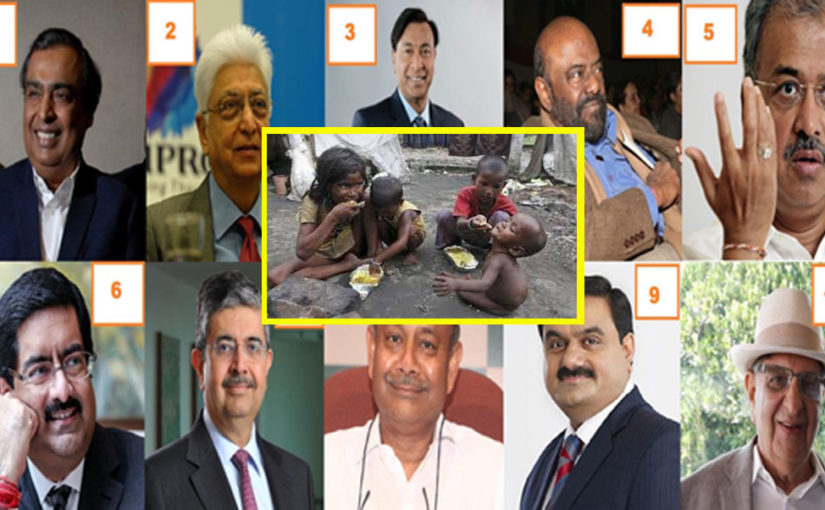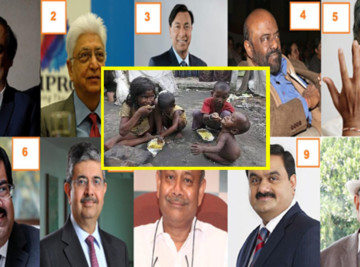Inequality in India
History of inequality in India
India is a vast and diverse country, with regional differences in food, dress, language, etc. These differences usually have served to bond us stronger. in recent years India has become one of the fastest-growing economy in the world but unfortunately it continues to remain one of the most unequal countries in the world. India as a country is struggling to overcome inequalities based on gender, caste, opportunities and most important of all economic inequalities.
What is inequality?
Inequality is a very simple yet vast term and hence open to various interpretations. By definition inequality is the unfair situation in society when some people have more resources, opportunities, money, etc. than other people. Now, if we look around us then most of us in India have or are facing it on a daily basis, be it inequality due to economic, caste, opportunities. Various studies have repeatedly highlighted this inequality but the government hardly pays heed. to it, maybe this is due to political compulsion to focus more on top-grade pool of population, but in reality, its longterm political and democratic repercussions are going to be very expensive for the country. Inequality can be broadly categorized into two types, inequality based on social strata and economic strata. Usually, one inequality leads to others as they are intertwined. Caste inequality is so deep-rooted that it still exists 73 years after our independence from foreign rule and interestingly very few steps being taken to eradicate it.
Economic Inequality: Perhaps this is the most quantifiable form of inequality. This can be subdivided into many categories, but income inequality and wealth inequality are two major ones. Income inequality is the inequality in which disparity in the incomes is taken into consideration and this is where the difference between the top percentile and bottom percentile of the population is very wide and vast. wealth inequality measures on the other hand, is the difference in the total wealth of an individual, and this is also, a point where the top and bottom are divided by an ocean and that is impossible to sail through.
The poor in India are struggling even to earn a minimum wage and hence have negligible or nil access to education and healthcare. On the other hand, rich are getting richer at a very fast pace and the resulting rate at which the gap between rich and poor is widening is worrisome.
If we examine wages in public, private-formal and informal sectors in India, we find the average wage of a formal private sector employee is higher than that of a public sector employee. And in the private formal sector, the differences in wages among workers are the highest. Wage inequality among regular workers is considerably higher than that among casual workers. Workers in the formal sector in India earn three times more wages than those in the informal sector. Surprisingly, wage inequality among women is the highest in public sector jobs in the country. A substantial wage gap also exists between workers engaged in different sectors.
The wage differential is higher among women than their male counterpart and inequality is much higher in women than in men.
Factors making poor in India more poorer
India spends approximately 1% of its GDP on the healthcare sector and approximately 4.5% on education. This expenditure is very little, considering the fact that education and healthcare should be of utmost importance for any nation. The government is not keen to spend on these two crucial sectors and wants private players in it. There is always news about private hospitals not doing their duties when it comes to treating poor people and therefore it’s the poor who suffers most. The past track record of private companies in India in these two sectors is not very encouraging either. If we consider education, in which there are already private players from primary education to higher, we see that they have failed on many counts to prove themselves.
Healthcare spending by the government in India has always been a matter of worry and ranks among the lowest in the world. India has promoted an increasingly powerful commercial health sector, instead of government-funded health service and hence India has reached a point where ‘health and healthcare is a luxury’ and available to the money-ed.
So, ironically today, the Poorest Indian states have infant mortality rates higher than those in sub-Saharan Africa. Every year we see a large number of children die due to malnutrition, diarrohea, pneumonia, encephalitis (brain fever), and other diseases. India still accounts for very high global maternal deaths of about 17%, and about 21% of children below age five die every year in India. These numbers are shameful, considering the fact that India is one of the top destinations for medical tourism.
The public health system has failed the poorest living in slums, and even middle-class people find it very difficult to access the government health care system. There are inadequate hospitals, dispensaries, primary health care centres, and where they exist, they are ill-equipped and under-staffed, non-availability of doctors push the common man to go to private hospitals.
It is shocking that in India, a very big portion of the Indian population is not able to access the health care they need. It is estimated that about 63 lakh Indians are pushed into poverty because of backbreaking healthcare costs every year – almost two people every second. So, effectively we are making more people poorer every day than alleviating poor.
Healthcare is one of the biggest reasons for the poor to become poorer and push back the middle class into poverty.
Let’s take a quick look at the recent (2018) numbers to the magnitude of inequality in India better.
The top 10% of the Indian population holds 77.4% of the total national wealth. 73% of the wealth generated in 2017 went to the richest 1%, while 67 million Indians who comprise the poorest half of the population saw only a 1% increase in their wealth.
There are 119 billionaires in India. Their number has increased from only 9 in 2000 to 101 in 2017. Between 2018 and 2022, India is estimated to produce 70 new millionaires every day.
Billionaires’ fortunes increased by almost 10 times over a decade and their total wealth is higher than the entire Union budget of India for the fiscal year 2018-19, which was at INR 24422 billion.
It would take approximately 900 years for a minimum wage worker in rural India to earn what the top paid executive at a leading Indian garment company earns in a year.
In the pre-reform period, the public sector played a crucial role in maintaining regional equality in the Indian economy by directing resources to backward areas. With a change in the focus of the public sector following the reforms, this process has become weaker. They also gave greater freedom and impetus to the private sector and export-oriented production. These sectors, which were attempting to reduce their costs and become competitive, were attracted to areas that were relatively more developed and thereby logistically easier to cater to and reach. As a result, investment and activity shifted to these areas, strengthening the forces of divergence.
So, whereas economic reforms did help improve India’s overall economic picture, the truth about our healthcare availability and infrastructure remains grim as we have realized during the current COVID pandemic. The government must shift focus and plan, restructure spending, and strengthen key sectors, like education, social security, healthcare, and infrastructure.
Author would like to thank oxfam india for the information.
Data source: oxfam India

